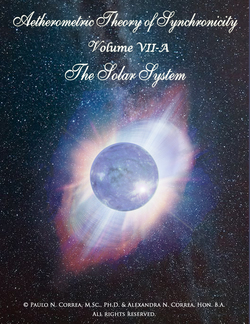![Akronos logo]](/images/akronos_wheel.jpg)
|
Akronos Publishing Concord, ON, Canada www.aetherometry.com |
![Akronos logo]](/images/akronos_wheel.jpg)
|
Akronos Publishing Concord, ON, Canada www.aetherometry.com |

The Wake and the Spin of the Solar System:
How the Barycentric Motion of the Sun Is Coupled to the Solar Apex
and, Together with the Sun's Drift, Accounts for Orbit Eccentricity
by Correa, Paulo N. & Correa, Alexandra N.
Published in May 2023. 72 pages.
Aetherometric Theory of Synchronicity, Vol. 7
Monograph AS3-VII.4
Price: US $40
|
ABSTRACT
Using the Earth's orbital as example, the authors present a novel theory of the eccentricity of planetarian orbitals, where a solar drift on the orbital plane combines with the barycentric oscillation of the Sun. The solar barycentric oscillation is analyzed as a component of the rotary wake which the Sun and the solar system execute in the direction of the solar apex, since the two motions share the same periodicity. The drift of the Sun with respect to the Earth defines a velocity vector v1 on the plane of the ecliptic towards the winter solstice, 5.9° away from the apex of galactic ambipolar radiation (+28.988°, 5.708h) and outgoing H• wind. The total solar drift (which includes the linear displacements caused by the equinoctial and apsidal precessions) points to perihelion. The directions of either vector will vary from planet to planet as per their orbital plane, and will precess with time. Re-analysis of the direction and velocity of the solar apex raises doubts regarding the formation of the helium/hydrogen cone of the local interstellar medium (LISM). Rather, the cone appears to be the result of atomic hydrogen collisions between the outgoing wind and the incoming, extra-galactic nebular hydrogen, and the crossover of the latter with an inleading galactic compression wave appears to be the real wavefront driver of the solar apex, since it affects nearby stars. The solar-apical motion surprisingly abides by Kepler's second law, even as an entirely new, energy-based (aetherometric) algebraic treatment of the gravitational work involved in a two- body system is provided that demonstrates how Kepler's second law breaks down and identifies the consequences that follow with respect to his third law. Together with the solar-apical motion, the barycentric oscillation of the Sun appears to be determinant of the sunspot cycle, and itself the result of a combination of epicycloidal motion and excentric revolution. It generates 3 types of loops, in agreement with existing data, and it is suggested that the overall cycle is 64 years: (2*10.667 yrs)*3 loops. A phase energy structure is also found for the barycentric and solar-apical motions, and their velocity-squared constant identified. |